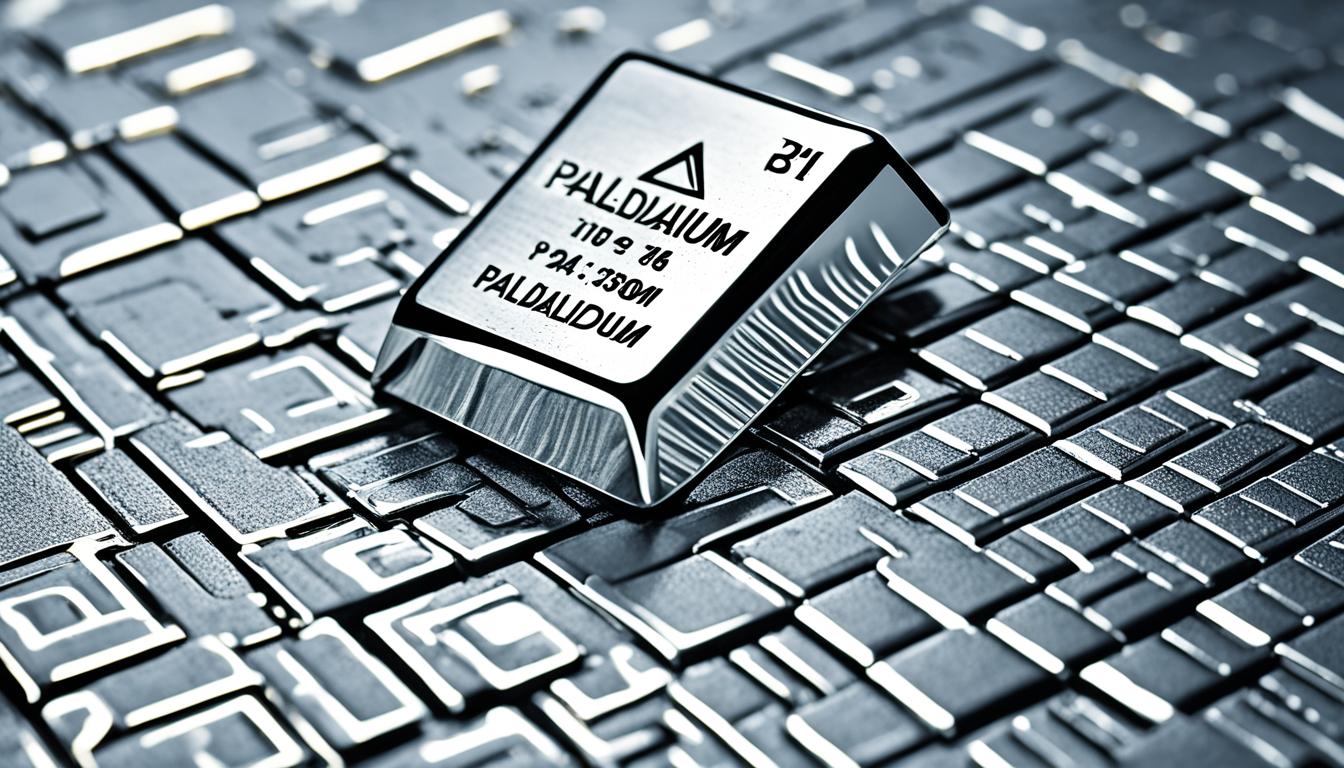Palladium is a rare and highly valued silvery-white metal. It has unique properties that make it valuable for many uses. It belongs to the platinum group, which also includes iridium, osmium, ruthenium, rhodium, and platinum. Palladium is a key element in catalytic converters and fuel cells, among other applications.
Palladium is not just for accelerating chemical reactions. It is also highly resistant to corrosion, has a high melting point, and can absorb lots of hydrogen. These characteristics mean it is useful in many industries. These include making cars, crafting jewelry, and in the investment market.
Introduction to Palladium
Palladium is a rare precious metal part of the platinum elements. It looks silvery-white and doesn’t rust easily. Because of this, the metal is in high demand around the world.
A Rare and Precious Metal
This metal is quite rare on Earth. It’s very valuable because it’s hard to find and has great properties. Industries rely on it for different uses, highlighting its importance.
Discovered in the 19th Century
Palladium was found in the early 1800s by William Hyde Wollaston. He got it from platinum ore. And he named it after Pallas, an asteroid found a year before.
Since its finding, palladium has been key in making many things. These include car converters, electronics, and jewelry. Its special features and scarcity make it a highly sought-after metal.
What is Palladium?
Palladium is a rare and valuable palladium metal that comes from the platinum family. It’s known for its special palladium properties and palladium characteristics. These include:
- A very high melting point, perfect for places that get super hot
- Not easily borken by rust, so it lasts a long time in different places
- It’s really good at passing on electricity, making it great for making things work
- Can suck in a lot of hydrogen, which is very unique and useful in many ways
People found palladium in 1803. The English chemist William H. Wollaston was the first to get it from rough platinum found in South Africa. He named it “palladium” after the asteroid Pallas. Pallas was named after the Greek goddess of wisdom.

Since then, palladium has been very popular for being rare and having special uses. Its palladium definition means it’s a rare metal used in things like cleaning car exhausts, making electronics, and beautiful jewelry. It’s a very important material for many fields.
Properties of Palladium
Palladium is a unique metal known for its special physical and chemical traits. It looks silvery-white, much like platinum. This makes palladium a standout metal just by its looks.
One key palladium physical properties is its high melting point, at 1,554°C (2,829°F). This means palladium suits use in very hot places. It keeps its shape even under extreme heat due to this palladium melting point.
Corrosion Resistant
Palladium is very resistant to rust, which keeps it strong in different settings. It stays shiny in the air at regular temperatures. This palladium chemical property helps it last long and be used in many ways.
Excellent Conductor of Electricity
Being an excellent conductor of electricity, palladium is big in the electronics field. Its conductive nature is very valuable. It’s perfect for parts and circuits that need the power to flow well.
Absorbs Large Amounts of Hydrogen
One intriguing palladium chemical property is how much hydrogen it can soak up. Palladium can take in up to 900 times its volume in hydrogen. This is vital for cleaning hydrogen, storing it, and for many chemical reactions in industry.
Palladium Sources and Production
The palladium mining field mainly thrives in Russia and South Africa. They produce about 80% of the world’s palladium. These nations are key palladium suppliers.
In South Africa’s Merensky Reef, layers of rocks carry a lot of platinum-group metals. The Bushveld Complex is also rich in palladium, along with platinum and rhodium.

Russia holds the Norilsk-Talnakh site in Siberia, a major spot for palladium mining. This area, known for nickel, copper, and palladium, is crucial for the world’s palladium supply.
Major Producers: Russia and South Africa
Russia and South Africa are top palladium producers. They supply a big part of the global demand. Big names include Norilsk Nickel from Russia and Impala Platinum from South Africa.
Mined from Igneous Rock Deposits
Palladium mainly comes from special rock formations deep in the Earth. Rocks like the Merensky Reef and Norilsk-Talnakh are rich in palladium. It’s part of a group known as platinum-group metals.
Limited Global Supply
Each year, only about 210,000 kilograms of palladium is produced. This isn’t much, which is why palladium can be expensive. It’s a sought-after material in several fields and by investors.
Industrial Uses of Palladium
Palladium is a key material in a range of sectors, especially in palladium industrial applications. Its use in making palladium catalysts for cars is significant. These catalysts help cars reduce their harmful emissions, turning pollutants into safer elements.
Catalytic Converters
The major use of palladium is in making catalytic converters for cars. These devices, which rely on palladium catalysts, change harmful gases into more benign ones. This is important for limiting the impact of car emissions on our environment.
Dental Alloys
Palladium also finds a place in palladium dentistry. It’s found in dental alloys for fixings like crowns and bridges. This is due to its non-tarnishing, non-corrosive, and body-friendly properties, ensuring dental work lasts a long time.
Electronics Components
In the palladium electronics industry, its special features are highly valued. It’s vital for making capacitors used in phones, computers, and cars. Its great ability to conduct and endure high heat helps these gadgets work well.
- Palladium Industrial Catalyst Production
- Palladium Dental Alloy Manufacturing
- Palladium Electronics Component Fabrication
- Palladium Pharmaceutical Compound Synthesis
Pharmaceutical Industry
The palladium pharmaceuticals sector uses this metal as a catalyst. It’s crucial for creating medications and other important chemicals. Palladium’s role in these processes aids in making medicines that save lives.
Palladium in Jewelry
Palladium’s shiny, white look and strong build have made it very popular in the jewelry world. It’s seen as a great alternative to platinum. This has pleased both makers and buyers, drawing them to its beauty and durability.
White Gold Alloys
Palladium is key in making white gold alloys look stunning. Mixing it with gold creates a delicate, silver-white shine that’s elegant. It doesn’t even need coating for this shine to last.
Alternative to Platinum
Though platinum has its own appeal, palladium is making its mark as a standout choice. It shines brightly and is both light and strong, perfect for special jewelry like engagement rings. And, it’s cheaper than platinum, which makes it more preferred by shoppers looking for value.
Palladium rings, necklaces, and bracelets show off the metal’s power to combine durability with beauty. As more people look for unique, long-lived pieces, palladium stands out. It is set to win over the jewelry-loving world with its charm and wearability.
Investing in Palladium
Palladium is a top choice for those wanting to mix things up in their investment portfolio. This rare metal is in limited supply and has a lot of demand from industries. That makes it a promising investment for the future.
Investment Opportunity
Its rarity and uses in many fields have made palladium stand out. It’s key for car parts, like catalytic converters, and it doesn’t rust or stain. So, it’s also big in making jewelry and electronics.
Volatile Pricing
Yet, betting on palladium has its ups and downs. The palladium price volatility is influenced by many things, like world events, supply troubles, and changing demand. This can lead to big price changes, making it a tricky but exciting investment.
Investment Options
If you’re keen on palladium, you have a few roads to explore. You could buy palladium bullion as bars or coins for physical ownership. Or try palladium ETFs, which follow its price but don’t need you to store the metal. For a bit of a gambling thrill, there are also palladium futures and other bets on its future costs.
But no matter how you choose to invest, do your homework. It’s important to know the risks and perhaps get advice from experts. This way, you can make palladium work for your financial plans and comfort level.
Conclusion
In summary, palladium is a rare and sought-after metal. It’s key in many fields, including making cars cleaner, building electronics, and in medicine. Its unique features have caught the eye of investors. Even though its price can go up and down, palladium’s role in our world is vital.
Technology and environmental rules getting tighter will only increase its value. Whether in fuel cells or beautiful jewelry, palladium matters a lot. It has a special talent for cleaning the air and handling extreme heat. This makes it crucial in creating cleaner and more effective products.
In the future, palladium will become even more essential. Our focus on being greener and innovative will boost its importance. Its many uses and rareness will keep it highly desired worldwide.




